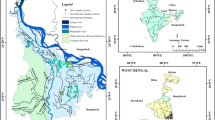Abstract
The ability to properly manage the oxidation of pyritic minerals and associated acid mine drainage is dependent upon understanding the chemistry of the disposal environment. One accepted disposal method is placing pyritic-containing materials in the groundwater environment. The objective of this study was to examine solubility relationships of Al and Fe minerals associated with pyritic waste disposed in a low leaching aerobic saturated environment. Two eastern oil shales were used in this oxidizing equilibration study, a New Albany Shale (unweathered, 4.6 percent pyrite), and a Chattanooga Shale (weathered, 1.5 percent pyrite). Oil shale samples were equilibrated with distilled-deionized water from 1 to 180 d with a 1∶1 solid-to-solution ratio. The suspensions were filtered and the clear filtrates were analyzed for total cations and anions. Ion activities were calculated from total concentrations. Below pH 6.0, depending upon SO 2−4 activity, Al3+ solubility was controlled by AlOHSO4 (solid phase) for both shales. Initially, Al3+ solubility for the New Albany Shale showed equilibrium with amorphous Al(OH)3. The pH decreased with time, and Al3+ solubility approached equilibrium with AlOHSO4(s). Below pH 6.0, Fe3+ solubility appeared to be regulated by a basic iron sulfate solid phase with the stoichiometric composition of FeOHSO4(s). The results of this study indicate that below pH 6.0, Al3+ solubilities, are limited by basic Al and Fe sulfate solid phases (AlOHSO4(s) and FeHSO4(s)). The results from this study further indicate that the acidity in oil shale waters is produced from the hydrolysis of Al3+ and Fe3+ activities in solution. These results indicate a fundamental change in the stoichiometric equations used to predict acidity from iron sulfide oxidation. The results of this study also indicate that water quality predictions associated with acid mine drainage can be based on fundamental thermodynamic relationships. As a result, waste management decisions can be based on waste-specific/site-specific test methods.
Similar content being viewed by others
References Cited
Adams, F., and Rawajfih, 1977, Basalumiminite and alunite: a possible cause of sulfate retention by acid soils: Soil Science Society of America Journal, v. 41, p. 686–692.
Filipek, L. H., D. K. Nordstrom, and W. H. Flicklin, 1987, Interaction of acid mine drainage with waters and sediments of West Squaw Creek in the West Shasta mining district, California: Environmental Science and Technology, v. 21, p. 388–396.
Griffin, R. A., R. M. Schuller, J. J. Suloway, N. F. Shimp, W. F. Childers, and R. H. Shiley, 1980, Chemical and biological characterization of leachates from coal solid wastes: Environ. Geol., note no. 89. Illinois Institute of Natural Resources State Geological Survey, Urbana IL.
Lindsay, W. L., 1979, Chemical equilibria in soils: New York, Wiley-Interscience.
Martin, J. F., 1974, Quality of effluents from coal refuse piles: First symposium on mine and preparation plant refuse disposal, Louisville, KY.
Nordstrom, D. K., 1982a, The effect of sulfate on aluminum concentrations in natural waters: some stability relations in the system Al2O3-SO3-H2O at 298 k. Geochimica et Cosmochimica Acta, v. 46, p. 681–692.
Nordstrom, D. K., 1982b, Aqueous pyrite oxidation and the consequent formation of secondary iron minerals,in J. A. Kittrick, D. S. Fanning, and L. R. Hossner, editor. Acid sulfate weathering: Madison, WI, Soil Science Society of America, p. 37–56.
Nordstrom, D. K., E. A. Jenne, and J. W. Ball, 1979, Redox equilibria of iron in acid mine waters.in E. A. Jenne, editor, Chemical modeling in aqueous systems: American Chemical Society Symposium, v. 93, p. 857–892.
Rhodes, E. R., and W. L. Lindsay, 1978, Solubility of aluminum in soils of the humis tropics: Journal of Soil Science, v. 29, p. 324–330.
Runnells, D. D., and R. D. Lindberg, 1981, Hydrogeochemical exploration for uranium deposits: use of the computer model WATEQFC: J. Geochem. Explor., v. 15, p. 37–50.
Smith, R. M., W. E. Grube, T. A. Arkle, and A. A. Sobek, 1974, Mine soil potentials for soil and water analysis: Washington, D.C., EPA 670/2-74-070, U.S. Environmental Protection Agency.
Sullivan, P. J., S. V. Mattigod, and A. A. Sobek, 1986, Dissolution of iron sulfates from pyritc coal waste: Environmental Science and Technology, v. 20, p. 1013–1016.
Van Breeman, N., 1973, Dissolved aluminum in acid sufate soils and in acid mine waters: Soil Sci. Soc. Amer. Proc., v. 37, p. 694–697.
Wahler, W. A., 1978, Pollution control guidelines for coal refuse piles and slurry ponds. Cincinnati, OH, U.S. Environmental Protection Agency, EPA 600/7-78-222.
Author information
Authors and Affiliations
Rights and permissions
About this article
Cite this article
Sullivan, P.J., Yelton, J.L. & Reddy, K.J. Solubility relationships of aluminum and iron minerals associated with acid mine drainage. Environ. Geol. Water Sci 11, 283–287 (1988). https://doi.org/10.1007/BF02574817
Issue Date:
DOI: https://doi.org/10.1007/BF02574817




